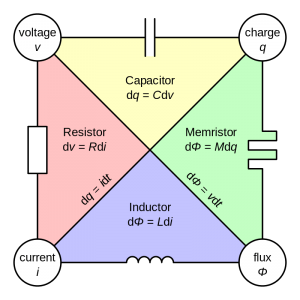Memristor
The Memristor is a device that was theoretically predicted in 1971 by Leon Chua but not demonstrated in practice until 2008. It is one of the four Fundamental Circuit Elements. The full collection is:
- Resistor
- Capacitor
- Inductor
- Memristor
The diagram below shows how they relate to the physical elements of Voltage, Current, Charge, and Magnetic Flux.
While we have been aware of Resistors, Capacitors and Inductors for a long time, and they are in common use, the Memristor is a very different proposition. The relationship between flux and charge implies storage of information as one possible use.
In practice, there is still quite a bit of controversy surrounding the Memristor and whether the 2008 discovery of non-linearity in TiO2 films really was a Memristor effect. And then there is the difficulty of getting our thinking around just how to make one, use one or even measure one.
The image above shows the device used by HP to demonstrate Memristor effect. The wires are only 150 atoms wide and the flow of current depletes the Oxygen causing a steady shift in electrical resistance. At its heart, the Memristor effect means that the resistance of the device is a function of the sum of the current that has previously flowed through it. And so the HP device appears to do this. Hence their claim of discovering the first tangible evidence of the real existence of the Memristor.
My first thought here is that to measure its resistance, you have to flow some current through it and therefore change it. So as a memory element, this change would need to be a small percentage of its current state to retain the memory for many access cycles. Or it could need refreshing like DRAM does. All ideas others have had I am sure.
Memristor as Neuron
A recent article in IEEE Spectrum on Mimicking the Synapses of the Brain suggests a Memristor could be used to replicate the behaviour of neurons. This relies on the effect of Calcium flow in neurons altering their state. Much like current in a Memristor alters its resistance. So this also looks like a plausible use of the device.
Commercial availability was predicted for 2018 but this still seems premature. We have been using Resistors, Capacitors and Inductors for more than a century (a lot more) and so we can expect this to take a little while to work out. We have only had 8 years to explore this new territory.
Successful Endeavours specialise in Electronics Design and Embedded Software Development, focusing on products that are intended to be Made In Australia. Ray Keefe has developed market leading electronics products in Australia for more than 30 years. This post is Copyright © 2016 Successful Endeavours Pty Ltd.





